Kyoto, Japan - Travel

Tours, Places to Visit, and Things to Do in Kyoto
Kyoto Travel Guide
Experience the best of Kyoto travel in our comprehensive guide. Once Japan’s imperial capital (794-1868), Kyoto (京都) dazzles with the finest achievements of Japanese art, culture, and spiritual heritage. Here, tranquil ponds reflect in water the beauty of pavilions with gracefully curved roofs, while pine trees seem to sprout seamlessly from rocks.
Nestled in the heart of the Kansai Region and encircled by mountains, this vibrant home to approximately 2.55 million people invites visitors to explore its 17 UNESCO-protected historical monuments and countless other treasures. Whether you are drawn by its rich history or natural beauty, our Kyoto Travel Guide 2025 will help you to plan your trip.
Kyoto Tours
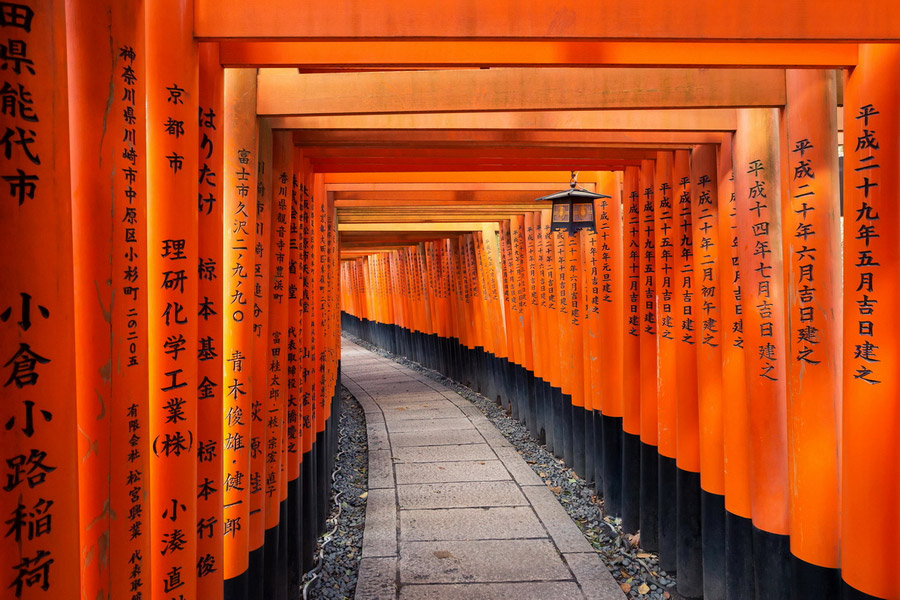
Visitors can encounter the timeless allure of Kyoto through various Kyoto tours revealing its historical and cultural charm. These are walking excursions through iconic attractions, such as the Arashiyama Bamboo Forest and Garden, or tasting local delicacies – like oysters, golden tempura, or sashimi made with freshly sliced fish. An elegant dinner with a geisha in the famous Gion district will add to the unforgettable memories of any voyager. Food tours at Kyoto’s vibrant Ponto-chō (先斗町) district and izakaya bars will leave lasting impressions. The high aesthetic of a tea ceremony will satisfy holidaymakers seeking authenticity. Unique explorations include sake tasting in Fushimi, zen meditations at a Buddhist temple, or attending a traditional Noh performance. Art lovers will enjoy a guided tour of the Kanjiro Kawai Museum, a 20th-century poet, sculptor, philosopher, and potter, while adventurers can browse UNESCO World Heritage sites on a cycling tour or take to the skies on a thrilling hot-air balloon or helicopter ride.
Best Time to Visit Kyoto
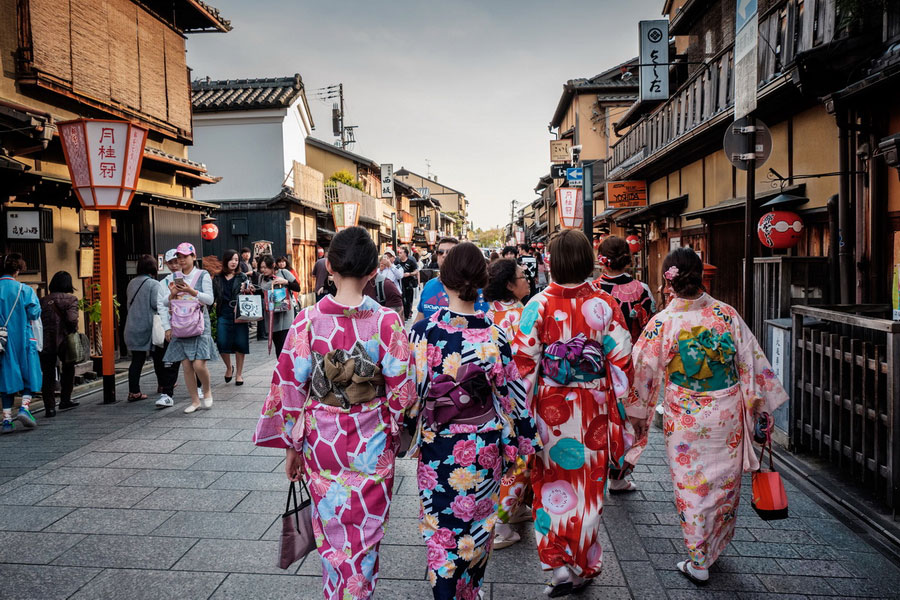
The best time to visit Kyoto on a holiday is from March to May and from September to November.
Spring in Kyoto welcomes travellers to experience the colours of plum and cherry blossoms, with Sakura trees blooming from late March to mid-April. Booking Shinkansen and accommodation in advance is essential, especially during the Golden Week and Aoi Matsuri in May.
The radiance of fall foliage in autumn creates a brilliant mise-en-scène. One of Kyoto’s biggest annual events, the Jidai Matsuri (時代祭), takes place on October 22, a festival celebrating the anniversary of Kyoto’s foundation. Summer, though humid and rainy, draws visitors for the Gion Matsuri, lasting the entire month of July.
Winter in Kyoto spans between December and February, with temperatures hovering around zero, thus meaning fewer crowds and lower accommodation prices. Still, winter can be a fascinating time to travel to Japan. Snow-covered surrounding mountains, shrines, and temples offer bountiful scenery. And nothing tops a brisk stroll in near-freezing weather like a soothing soak in a traditional Japanese onsen. Additionally, the annual Kyoto Winter Openings provide a unique opportunity to browse unique sites typically not open to the public.
History of Kyoto
Kyoto's founding dates back to 794 CE when Emperor Kammu relocated the capital to this peaceful settlement. He named this new capital Heian-Kyō, which translates to "Capital of Peace and Tranquillity." The location of the capital and imperial palace was based on Feng shui – Chinese geomancy. The capital acquired its name, "Kyoto," around the 8th century.
It was a leading religious, political, and cultural centre of Japan until the Edo or Tokugawa period. However, the city was almost destroyed in the 15th century during the Ōnin War, taking it several decades to recover from the 16th century onwards.
Over the years, economic and political power slowly shifted to Edo, the capital of the Shogunate. In 1868, the Emperor Mutsuhito moved from Kyoto to Edo, naming it "Tokyo" (東京都) (Eastern capital). Some locals called the throne city "Sai-Kyo" (Western capital) to distinguish it from the new capital.
Fortunately, Kyoto was spared from the bombings of World War II, and today, the city stands out by its spectacular Shinto shrines and Buddhist temples, with 17 designated as UNESCO World Heritage Sites.
What to do in Kyoto?

Landmarks and Places to Visit in Kyoto
Kyoto boasts hundreds of landmarks, from vibrant gardens to peaceful sanctuaries, a geisha district, and fascinating markets with delicious food. Notably, 17 historical monuments of ancient Kyoto are protected by UNESCO. It’s almost impossible to confine them all to a single list. Below are the top Kyoto attractions a newcomer shouldn’t miss.
Top 4 UNESCO-Recognised Buddhist Temples in Kyoto

- The Golden Pavilion temple, or Kinkaku-ji (鹿苑寺) – An impressive structure covered in gold leaf with contrasting architecture on each floor.
- Kyomizu-dera temple (清水寺) – Another revered Buddhist temple in Kyoto, standing tall on the slopes of Mount Kyomizu (or Mount Otawa).
- Saihō-ji temple (西芳) – Famous for its pretty garden, originally built in the 7th century and rebuilt in 1339.
- Byōdō-in temple (平等院) – located in Uji of Kyoto Prefecture (14 kilometres from Kyoto), this temple represents the Buddhist Pure Land Paradise.
Top 4 Shinto Shrines

Shinto is Japan's most revered religion, closely followed in reverence by Buddhism. Kyoto alone is home to around 400 Shinto sanctuaries. The entrance to Shinto shrines is always preceded by a scarlet Torii gate, distinguishing them from Buddhist temples.
- Fushimi Inari-taisha Shrine (伏見稲荷大社) – The head Japanese sanctuary of Inari Ōkami, with thousands of Torii gates.
- Heian-Jingu Shrine (平安神宮) – Built in 1895 to celebrate Kyoto's 1100th anniversary, with a wonderful garden and a pond surrounded by hundreds of trees.
- Imamiya Shrine (今宮神社) – A quieter shrine in Kita Ward, featuring traditional dessert cafes, serving roasted Aburi-mochi rice cakes.
- Yasaka Shrine (八坂神社) – Located in Gion near Maruyama Park, it is the centre of the Gion Matsuri festival held in July.
Kyoto Museums
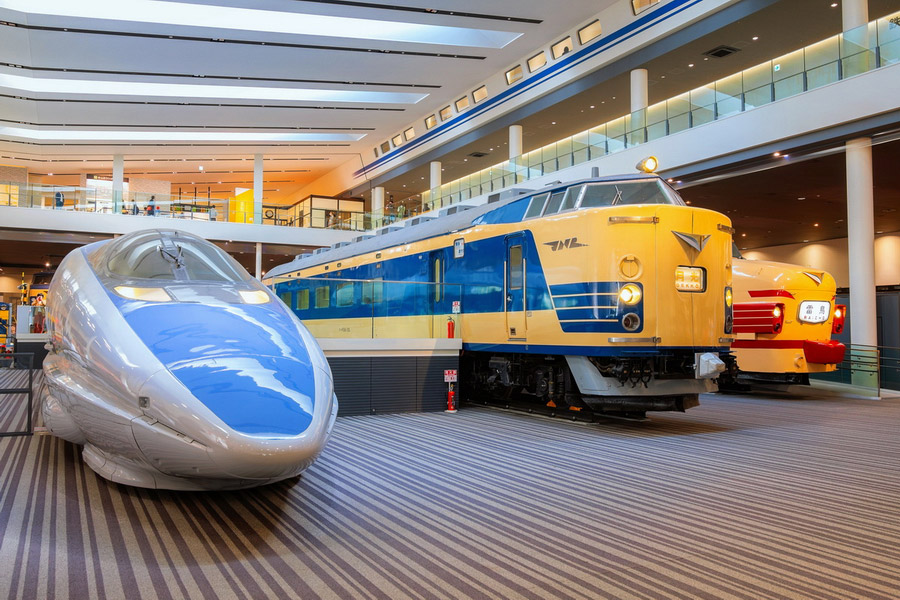
Kyoto museums cater to everything, from traditional art to samurai history. For anyone wishing to get a deep dive into Japanese culture and history, visiting Kyoto's museum is unmissable.
- Samurai and Ninja Museum – Try on samurai costumes, throw shuriken (ninja stars), and enjoy many other fun activities.
- Kyoto Railway Museum (京都鉄道博物館) – Where train enthusiasts can browse hands-on exhibits and locomotives and have lunch in a train car.
- Kyoto National Museum (京都国立博物館) – Focuses on Japan’s history through arts and crafts from Kyoto’s time as the capital. At the World Expo 2025, it will showcase 200 Japanese masterpieces, including Wind God and Thunder God Screens and The Great Wave.
- Kyoto City Kyocera Museum of Art's – Houses 19th and 20th-century paintings with English explanations.
- Gekkeikan Okura Sake Museum (月桂冠大倉記念館) – Discover sake-making history, taste samples, and buy bottles of sake to bring home.
- The Kaleidoscope Museum of Kyoto (京都万華鏡ミュージアム) – Has amassed several hundred kaleidoscopes from around the world. Guests can create or buy handmade kaleidoscopes.
Art Galleries in Kyoto
Kyoto’s art gallery scene reveals the town’s artistic evolution through the work of modern Japanese artists.
- Kyoto Art Centre – The main reference for contemporary art exhibitions, installations, performances, theatre, music, and dance.
- Aizenkobo – Specialises in a centuries-old craft of indigo-dyed textiles.
- Imura Art Gallery – Depicts modern interpretations of Noh plays.
- Mori Yu Gallery – Presents contemporary paintings of several Japanese artists, such as Ari Kuroda, Yusuke Nakano, Tomoko Jindo, Man Katano, and Hideyuki Igarashi, among others.
Theatres in Kyoto
For visitors who haven’t yet experienced Japan’s traditional theatre in Tokyo – or if Kyoto is a starting point of their journey – these exceptional venues promise enduring memories.
- Gion Kobu Kaburenjo Theatre is an essential visit for an introduction to classical Japanese performing arts. There, guests can marvel at the comedic wit of Kyogen, the refined grandeur of Bugaku and Kabuki, and the ethereal elegance of the geisha dance.
- Minami-za Theatre (南座), another celebrated venue in Gion for its Kabuki performances and Western dramas.
- Non-Verbal Theatre GEAR masterfully reimagines contemporary themes – robots, anime, and manga – in a visually arresting and wordless spectacle. Enthusiastic audience reviews speak volumes about the production’s cutting-edge technology and artistry.
- The Kyoto Kanze Kaikan Theatre and the Kongo Noh Theatre stage Noh performances, where masked actors embody ancient legends.
Entertainment, Parks, and Shopping in Kyoto
Entertainment

Kyoto’s entertainment scene is appealing. Here are three top neighbourhoods to find entertainment in Kyoto.
Strolling through Gion
Gion (around Shijo Avenue) is the top place for visitors, well-known for its geisha strolling around the narrow streets and Shinbashi-dori, which is said to be the prettiest in all of Japan.
By strolling through the Gion area in Kyoto, you will typically discover the Kyoto National Museum, Kiyomizu-dera temple, and the lofty Buddhist Yasaka Pagoda. Among the best tea houses for tea ceremonies in Gion is Kimono Tea Ceremony Kyoto Maikoya at Nishiki Ichiba (錦市場) market.
One thing to keep in mind is that due to impolite behaviours towards Geishas (geikos, in Kyoto) from visitors, limited access measures have been implemented in certain areas of Gion.
Strolling through Ponto-chō
Downtown Kyoto is home to the renowned Ponto-chō, a vibrant nightlife and traditional dining district along the Kamo River. Besides, Ponto-chō houses one of the Hanamachi where the geisha and maiko live.
Nearby, visit the ancient Imperial Palace, the Nijo Castle (二条城), and the Nishijin Textile Centre, selling handmade kimonos and other textile goods.
Strolling through Arashiyama (嵐山)
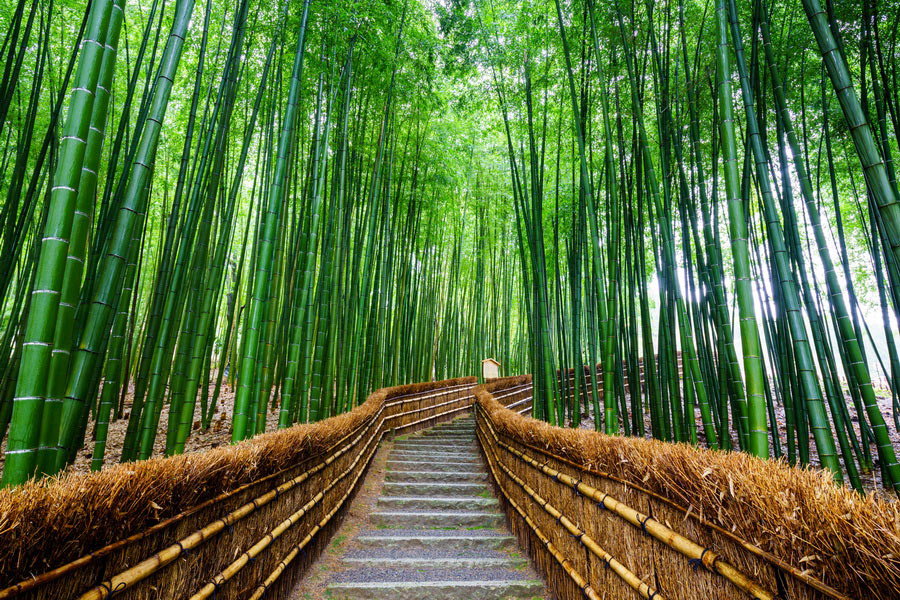
Places to visit in Arashiyama include the Zen-inspired Tenryu-ji Temple, the peaceful Arashiyama Bamboo Grove, and the Iwatayama Monkey Park (嵐山モンキーパークいわたやま), accessible via a 30-minute hike from the grove.
A one-hour ride on the Sagano Scenic Railway (嵯峨野観光鉄道嵯峨野観光線) along the Hozu River and Hozu Valley in autumn can be a real family adventure.
The 155-meter Togetsukyo Bridge (渡月橋) over the Katsura River prides itself on fantastic outlooks, and Kameyama-koen Park (亀山公園), across the bridge, is a prime spot for cherry blossom viewing. The area is also famous for Buddhist cuisine and tofu dishes.
Kyoto Parks
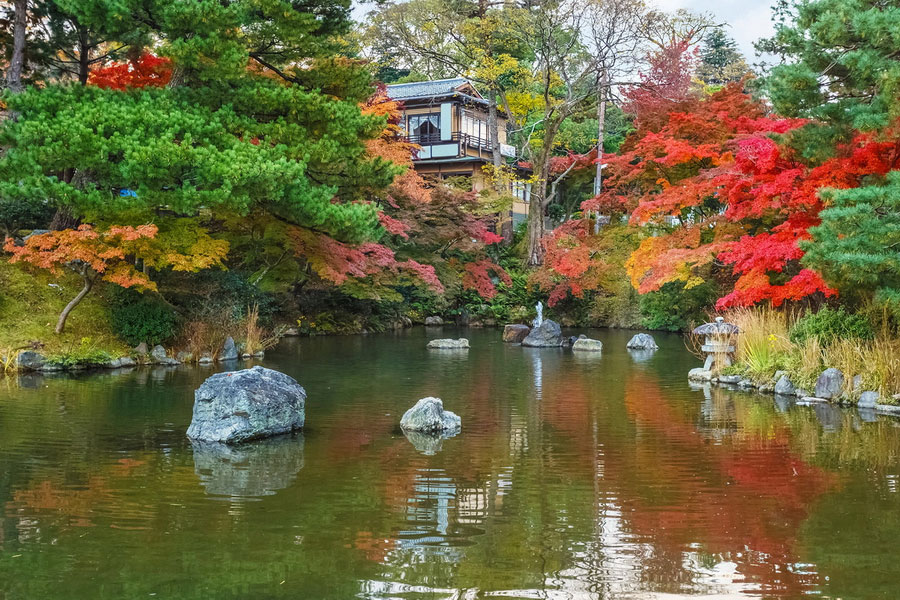
Kyoto is a beloved cherry blossom viewing destination with countless cherry trees. The top hanami meeting places are Maruyama Park (円山公園), where you can see a weeping cherry tree lit up at night, and the park at the former Katsura Imperial Villa (桂離宮). The latter is considered a masterpiece of Japanese landscape gardening.
The Kyoto Prefectural Botanical Garden (京都府立植物園) is next to the Kamo River. It is renowned for its enormous greenhouse with over 4,500 different species of plants.
Other notable gardens in Kyoto are the Japanese garden around the Ginkaku-ji Buddhist temple and the rock garden of Ryoan-ji (龍安寺).
The two theme and amusement parks that are worth visiting are the Toei Kyoto Studio Park and the Amanohashidate View Land.
Kyoto Theme Parks
The two theme and amusement parks that are worth visiting are the Toei Kyoto Studio Park and the Amanohashidate View Land.
Part of the Toei Company’s Kyoto Studio, this theme park and film set location opened in 1975. It cultivates a rendition of Japanese life during the Edo period, complete with traditional buildings, several themed zones, and exciting activities. Guests may encounter the actual filming and experience the Japanese world of cinema. Ninja, samurai, and geisha attires are available for rent.
Amanoshidate View Land is a charming park. Despite its modest size, it features attractions like a Ferris wheel, roller coaster, go-karts, and mini golf. Its crowning glory, however, is the elevated location atop a mountain with spellbinding views of the Amanohashidate Sandbar. It is conveniently situated just a 1.45-minute drive from central Kyoto.
Where to Play Golf in Kyoto?
At least two dozen picturesque courses surround Kyoto. Combining gorgeous gardens and pristine tee grounds, Kyoto Prefecture is well-tailored to provide for every golfer’s needs.
Kamigamo and Funayama Courses of Kyoto Golf Club remain the top golfing hotspots in the region. Launched by the U.S. military, the club was opened in 1948 following World War II.
A 40-minute drive from Gion, the Kyoto Ohara Public Course shows off 18 holes nestled atop a hill, 450 meters above sea level. Kameoka Golf Club, just a quick drive from Kyoto, is another great golf destination perfect for every skill level.
Shopping in Kyoto

Kyoto is packed with traditional shops that can take you back to ancient times when Kyoto was the capital. At the same time, travellers can easily find shopping malls and other modern stores to buy souvenirs and high-end goods.
- Kyoto Station Building – A massive mall with shops, restaurants, and an observation deck.
- Kyomizu Zaka Street – A historic street with arts, crafts shops, kimono, and local treats.
- Shinkyogoku Shopping District – A covered shopping area with gifts and food near Teramachi-dori.
- AEON Mall – Near the Kyoto Station, offers food courts, shopping, and entertainment.
- Ninja Dojo and Store – Engage in various ninja-themed activities.
- Touan Yasaka Gallery and Studios – Sells great Kyo pottery.
- Ohnishi Tsune Shoten – Specialises in Kyoto folding fans.
- Kyoto Handicraft Centre – Features Japanese dolls like Kokeshi and Hina.
- Fuuka-Kimono and Chiso – Beautiful kimono options.
Food in Kyoto

Learn about Japanese dishes you must try on your next visit to Kyoto, Japan.
Kaiseki Ryori – A refined multi-course meal using seasonal ingredients. Top kaiseki establishments include Izusen-Daijin Shop (Daitoku-ji Temple), Gyon Karyo, and Kodaiji Wakuden. Renowned Michelin-starred restaurants include Kikunoi Honen (Chef Yoshihito Murata), Gion Sasaki, and Hyotei (over 400 years of history).
Obanzai – A home-cooked Kyoto-style meal, requiring at least 50% of ingredients to be locally sourced. Try Kyosaimi Namura for authentic obanzai.
Kawayuka – Dine on wooden decks over the Kamogawa River to enjoy a cool summer breeze. Popular between Nijo-dori and Gojo-dori and in Kibune village.
Kyoto Egg Sandwiches – Thick omelette sandwiches served at Smart Coffee and La Madrague.

Nishiki Market – Sample mackerel sushi, Kyoto vegetables, and Uji green tea. Eating while walking is considered bad manners.
Vegetarian Restaurants
One of the staple dishes in Kyoto is shojin ryori, food rooted in Zen Buddhism, which will suit vegetarians and anyone wishing to diversify their diet with plant-based products.
Yudofu must be sampled at the Okutan Kyomizu, a tofu restaurant with a history of over 390 years near the Kyomizu-dera temple. This old eatery boasts pleasant views.
Other vegetarian and vegan restaurants in Kyoto: Zirael Vegan Restaurant, Veg Out, and AIN SOPH. Journey Kyoto.
Coffee Houses, Bakeries, and Patisseries
In the 21st century, Kyoto is brimming with an impressive array of retro-style kissaten (cafes) reminiscent of the 1930s and 1940s.
Among the most iconic is Salon de thé François, named in homage to the French painter Jean-François Millet, a charming French-style coffee shop that has been serving patrons since 1934 in a Japan-registered Tangible Cultural Property building. Other notable establishments are Inoda Coffee, Maeda Coffee, Ogawa Coffee, and Kagizen Yoshifusa (known for wagashi).
For sweet artistic confections, visit Rau Patisserie & Chocolate and AMI Patisserie. Gourmet-worthy bakeries include the City Bakery Kyoto Shijo Teramachi, Le Bac à Sable, Kyo Baum, and Liberte Patisserie Boulangerie Kyoto Kiyomizu.
Best Ryokans and Onsen in Kyoto
The best hotels to stay in Kyoto are Japanese traditional lodgings – ryokans. The country’s age-old customs are seen in mat flooring, shoji (sliding doors), low wooden tables, and beds. Still, the true attractiveness of ryokans lies in generous reception and access to nearby onsen with private rooms.
Some of the best onsen ryokans to add to the list are Suiran, Nazuna Kyoto Nijo-jo, Kyoto Machiya Fukune, Yunohana Resort Suisen, Kiraku Kyoto Honmachi, Katsuragawa, and Kurama.
Tenzan no Yu is a prominent public onsen in Kyoto, with outdoor and indoor hot spring baths, electric baths, and a variety of pools.
MICE in Kyoto
Kyoto is one of the premier destinations in Japan for business, rendering a rich cultural backdrop for MICE events. Beyond the city, Kyoto by the Sea, Woodland Kyoto, Kyoto Tea Country, and Kyoto Otokuni Bamboo Grove feature unique venues and diverse meeting facilities to combine business and tourism. These areas accommodate exceptional settings for conferences, incentive tours, and corporate retreats, with activities like tea-picking and traditional homestays. Businesses can take advantage of the Kyoto Convention & Visitors Bureau’s full support for venue recommendations and financial advice.
Key upcoming events in Kyoto include:
- The 6th Kyoto Conference on Arts, Media & Culture (KAM2025): 4-8 November, 2025.
- Art Collaboration Kyoto: 14-16 November, 2025.
- 32nd International Horticulture Congress (IHC2026 Kyoto): 23-28 August, 2026.
City Transport in Kyoto
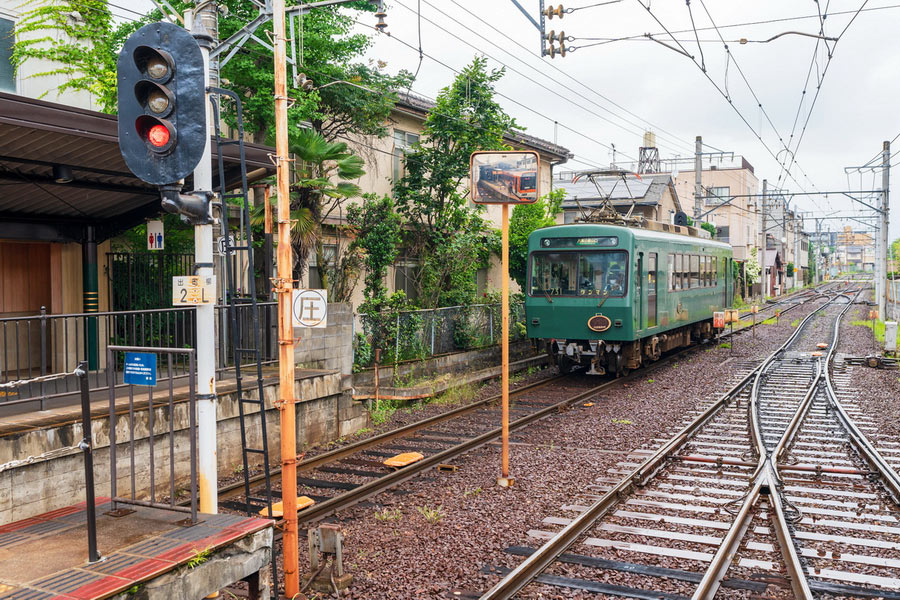
Kyoto is a pretty compact town with a decent transportation network. To help you navigate Kyoto conveniently and comfortably, we recommend considering the most comfortable transportation options.
ICOCA Prepaid Card
ICOCA works not just in Kyoto but also in the Kansai region (Osaka (大阪市) and Kobe (神戸市)). With this IC card of JR West for JR trains in Kansai, travellers can travel expeditiously around Kyoto on the subway, bus, and train.
Kyo-train Garaku
Hankyu Railway’s sightseeing limited express, the Kyoto-train Garaku, was first put on rails in 2019. Unlike Hankyu regular trains, the interior of this train is inspired by the classy architecture of Kyoto. Kyo-train Garaku connects Kyoto and Osaka, bringing the best of Kyoto on board.
Kyoto-Osaka Luxury Train
The Kintetsu Aoniyoshi Express debuted on April 29, 2022. The remodelled and uniquely styled carriages provide an elite trip from Kyoto to Osaka-Namba with a stop in Nara (奈良市).
Sagano Scenic Railway
The Sagano Scenic Railway is operated by West Japan Railway Company (JR). The slow-paced 25-minute journey on the line covers 7 kilometres, unfolding the amazing landscape of the forested ravine between mountains heading toward rural Kameoka.
Private Door-to-Door Transfers
Visitors in Kyoto can book a private taxi or car for a comfortable transfer to major attractions. Private transportation allows for direct travel from hotels to locations such as Fushimi Inari-taisha Shrine, Arashiyama, and Kinkaku-ji, as well as the nearby cities like Nara and Osaka.
Kyoto Helicopter Rides
VIP travellers can feast their eyes on the beauty of Kyoto on a private helicopter tour. Experience the excitement of gliding above the golden splendour of Kinkaku-ji, the Fushimi Inari-taisha Shrine’s torii gates, and the Kamo River.
How to Get to Kyoto

By Shinkansen
Kyoto is approximately 500 kilometres from Tokyo. Green Class (First Class) Tokaido Shinkansen trains, Nozomi and Hikari, offer comfortable rides from Tokyo to Kyoto. The whole journey takes around two hours. Green class passes have to be reserved well in advance.
By air
Another comfortable and fast way to reach Kyoto from Tokyo is by air. The nearest airport to Kyoto is Osaka Itami Airport (ITM), located one hour away by bus from the city centre. This airport primarily handles domestic flights, with the majority operating between Itami Airport and Tokyo Haneda Airport (HND); only a limited number of flights connect to Narita Airport (NRT). The average flight time between Osaka Itami Airport and Tokyo is around one hour. However, the Kansai International Airport (KIX), located about 1.5 hours away from Kyoto by train, handles international flights.
Languages Spoken in Kyoto
The primary language spoken by Kyoto residents is Japanese, the country’s official language. Despite this, visitors can easily navigate the city using English. Many young people and those employed in tourism speak decent English, and public transportation signs have English translations too. If you are uncomfortable with English, translation apps like Google Translate can be helpful.
Did you know?
Kyoto has a distinct dialect known as Kyoto-ben, part of the broader Kansai dialect family. Other varieties of the Kansai dialect are also spoken in Osaka. In Kagai, the district where geisha and maiko (apprentice geisha) reside, a unique dialect called kagai kotoba is still in use. It is traditionally expected that maiko-in-training learn to speak this refined dialect as part of their cultural education.
Currency in Kyoto

The monetary unit in Kyoto is the yen (¥, 円), the official Japanese currency.
Foreign currency exchange through ATMs using a debit or credit card is available at airports, banks, department stores, tourist places, large hotels, and even post offices in small towns and villages of Kyoto Prefecture. US dollar or euro notes can be exchanged at airports or local banks. However, getting the cash straight out of the ATM is the best way.
Visa, MasterCard, Maestro, Cirrus, American Express, Plus, and Visa Electron are widely accepted in Kyoto.
Did you know?
Japan released redesigned banknotes on July 3, 2024, introducing three new portraits. The “father of Japanese capitalism,” Eiichi Shibusawa (1840-1931), is on a 10,000 yen note. The 5,000 yen note uses the face of Umeko Tsuda (1864-1929), a prominent woman educator. The 1,000 yen note depicts Shibasaburo Kitasato (1853-1931), a great contributor to Japanese modern medicine.
Is Kyoto Safe?

According to Numbeo, the 2024 safety rate is “very high.” Solo travellers can feel very comfortable walking through the districts of Gion, Arashiyama, and Higashiyama. Yet taking basic precautions, like keeping your belongings close in busy areas and staying aware, will help visitors avoid potential minor risks of bag snatching or visitor scams. While crime during nighttime is rare, foreign visitors should be extra vigilant, specifically when walking alone around Kyoto Station or in the winding alleys of Ponto-chō.
In case of emergency, dial the police number 110 or the Tourist Information Centre at +81 50-3816-2787.

